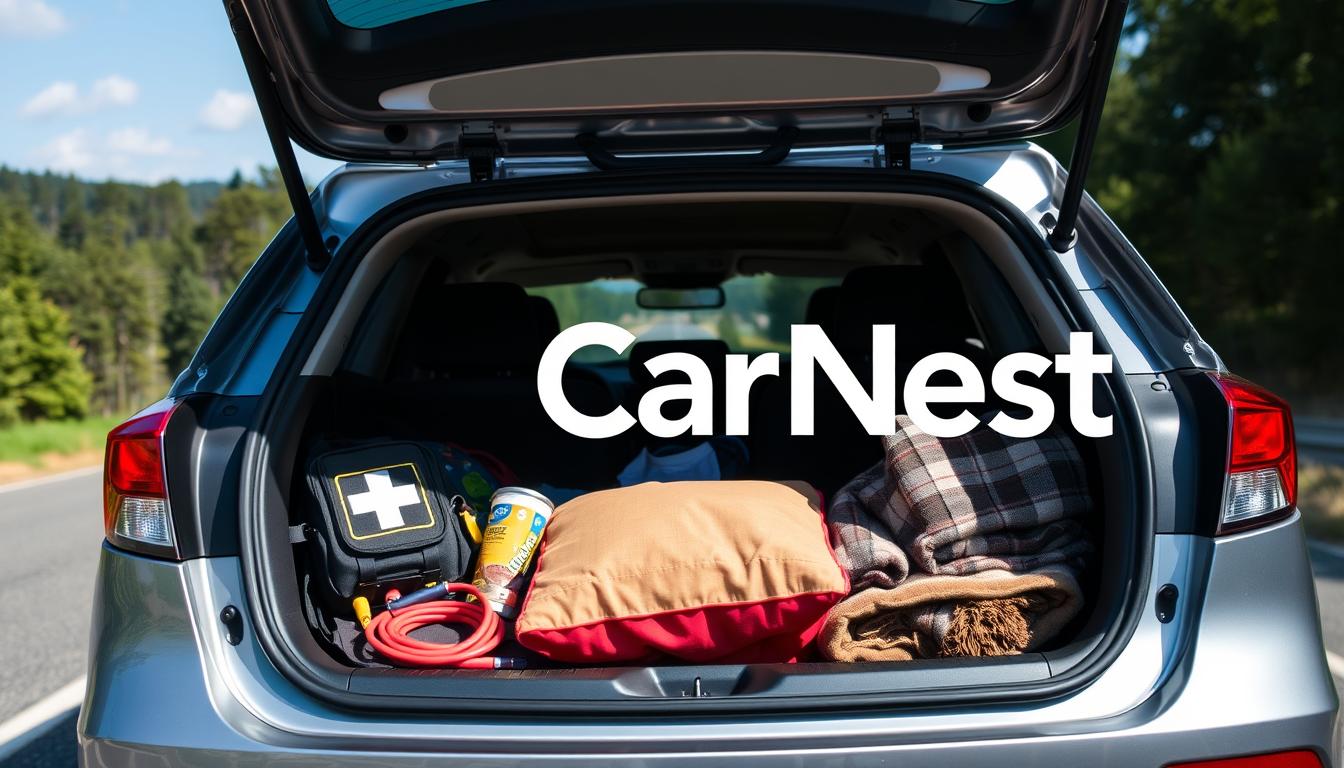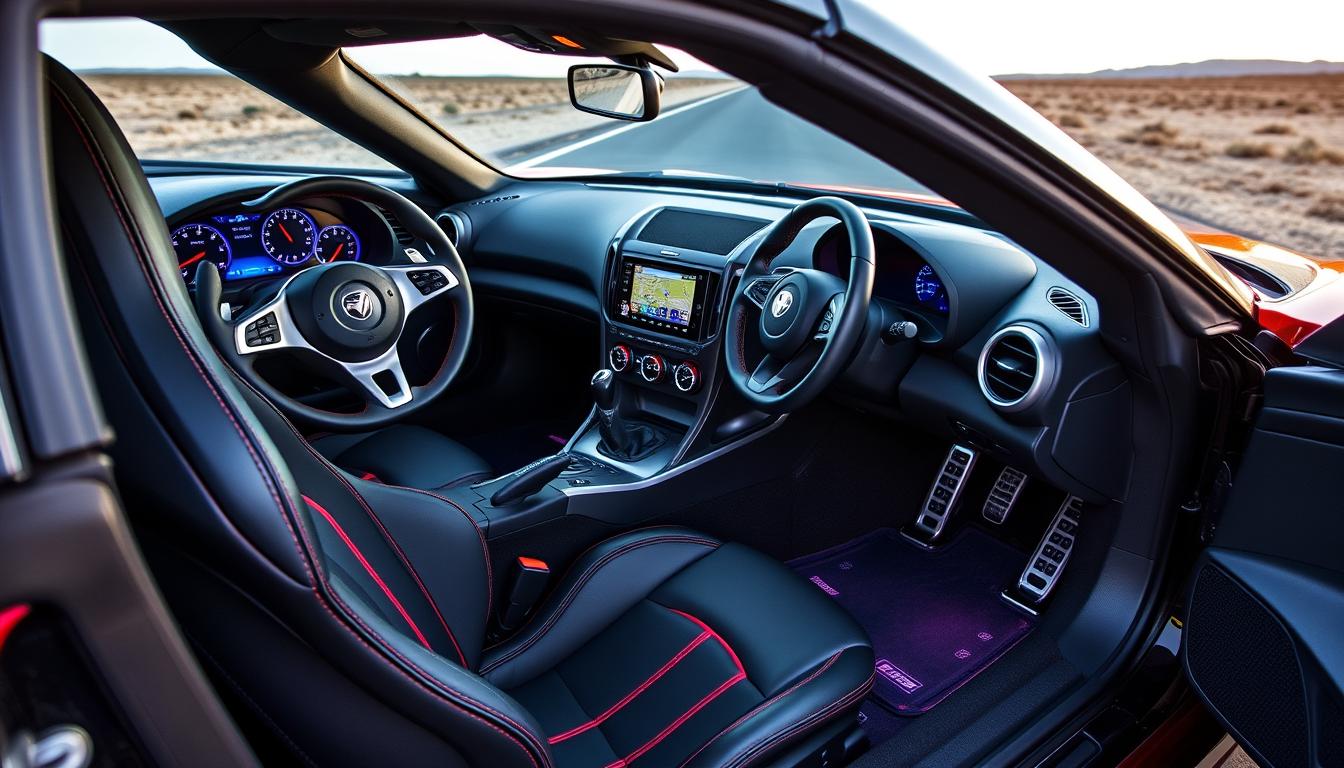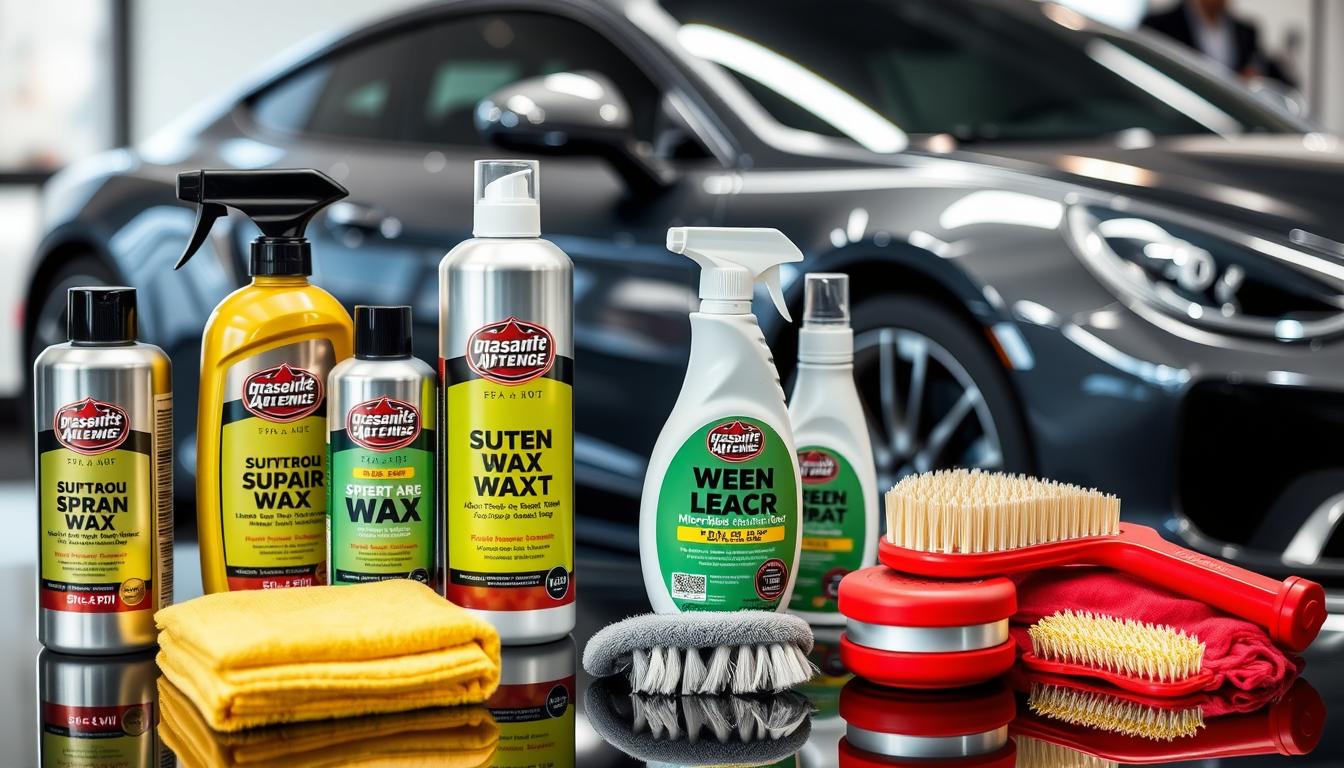We all want to stay safe while driving. The American Red Cross suggests a few key steps. Carry a Disaster Supplies Kit in your trunk and tell someone where you’re going and when you’ll arrive. These tips can help keep you safe on the road.
Keeping your vehicle in good shape is also important. Having a vehicle emergency kit and a plan can lower accident risks. Always check the weather forecast before you leave and keep your gas tank full. We’ll share more tips in our Driver’s Guide 2025.
Our aim is to help you stay safe while driving. By following these emergency tips, you can avoid accidents and enjoy your drive. Whether you’re going on a long trip or just running errands, your safety is our main concern.
Key Takeaways
- Carry a Disaster Supplies Kit in your trunk for emergency preparedness
- Let someone know your destination, route, and expected arrival time
- Monitor weather forecasts before traveling
- Maintain a sufficiently full gas tank to prevent being stranded
- Take breaks every 2 hours or 100 miles to reduce fatigue
- Use emergency preparedness tips to stay safe on the road
- Stay informed about road safety and emergency preparedness
Understanding the Basics of Road Safety
When we drive, keeping safe is key. We must focus on driver safety measures to avoid accidents. The American Red Cross offers tips for emergency readiness. These include having a plan, staying informed, and being ready for disasters.
Driving hazards like underinflated tires and distracted driving are common. To avoid these, we should check our tires regularly and stay focused while driving. Wearing seat belts and following traffic rules also help prevent serious injuries.
Here are some important driver safety measures to remember:
- Check tire pressure at least once a month and before long road trips
- Ensure tread depth is at least 2/32 of an inch on all tires
- Avoid distracted driving, such as texting or eating while driving
- Wear seat belts and ensure all passengers do the same
By taking these road safety precautions, we can lower the risk of accidents. Road safety is everyone’s responsibility. Let’s all work together to stay safe on the road.
| Driver Safety Measure | Importance |
|---|---|
| Regular tire checks | Prevents tire failure and reduces risk of accidents |
| Avoiding distracted driving | Reduces risk of crashes and fatal injuries |
| Wearing seat belts | Reduces risk of fatal injuries by 45% |
Essential Vehicle Maintenance Tips
Regular vehicle maintenance is vital for our safety on the road. Following the manufacturer’s maintenance guidelines helps prevent breakdowns and accidents. A well-kept vehicle also saves fuel and is eco-friendly. For more tips, visit vehicle maintenance tips.
Important maintenance tasks include checking tire pressure and tread, regular oil changes, and engine checks. Keeping brakes in good condition is also key. By doing these, our vehicle stays safe and efficient. Having a vehicle emergency kit in our car is also wise. It prepares us for breakdowns or accidents. Using defensive driving strategies daily can also lower accident risks.
Regular maintenance can prevent up to 1 million roadside breakdowns each year. By keeping up with our vehicle’s needs, we avoid being stranded. Always have a
https://www.youtube.com/watch?v=XCDK9hb3vag
in your car. Taking a defensive driving course can also enhance your safety on the road.
| Maintenance Task | Frequency | Importance |
|---|---|---|
| Tire Pressure Check | Monthly | High |
| Oil Change | Every 5,000 miles | High |
| Brake Pad Replacement | Every 30,000 miles | High |
Building an Emergency Kit for Our Vehicles
Keeping a well-stocked emergency kit in our cars is key to staying safe on the road. The kit should have a first aid kit, flashlight, and an emergency contact card, as the American Red Cross suggests. These items help us stay safe in case of emergencies.
Some important items for our emergency kits are:
- Non-perishable food and water
- Jumper cables
- Fire extinguisher rated for class B or class C fires
- Road flares or hazard triangles
- Work gloves
These items help us deal with common problems like flat tires and fires. Being ready can prevent accidents and keep us safe.
To learn more about making a complete emergency kit, check out the essential road trip safety kit guide. Remember, safety on the road comes from being prepared and keeping our cars in good shape. By doing this, we can enjoy our drives without worry.
Conducting a Pre-Trip Vehicle Check
Before we hit the road, it’s key to do a quick vehicle check. This simple step boosts driver safety measures and road safety precautions. It helps prevent accidents and makes our journey safer. The National Highway Traffic Safety Administration says regular checks can greatly lower accident risks.
A detailed pre-trip check can spot issues early. We should look at the tires, brakes, lights, and emergency gear like fire extinguishers and warning devices. By inspecting our vehicle, we can fix small problems before they turn into big ones or cause accidents.
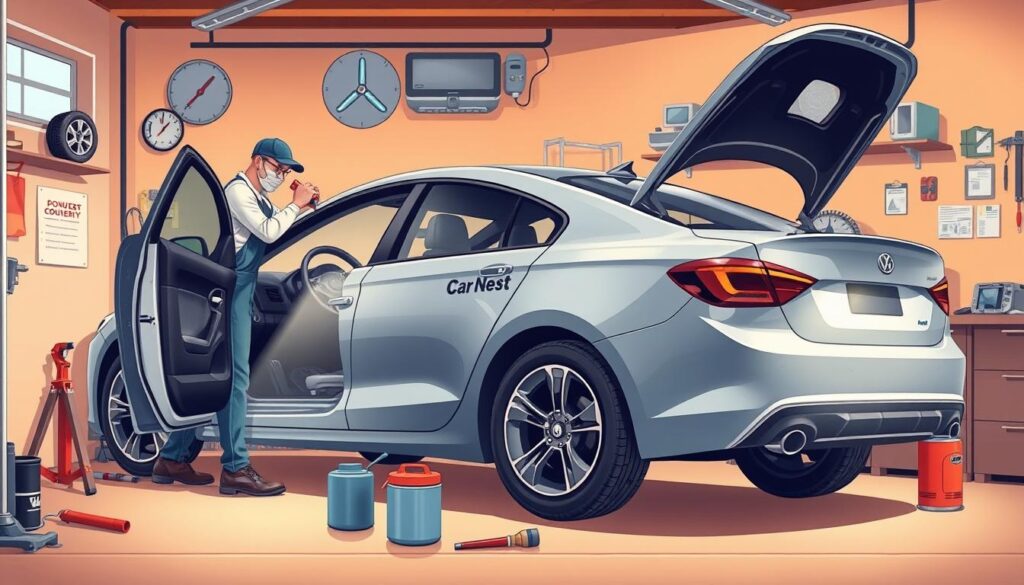
- Brake pads and slack adjuster push rod
- Tire tread depth and inflation
- Lighting and reflectors
- Emergency equipment, such as spare fuses and warning triangles
Adding these checks to our pre-trip routine boosts our driver safety measures and road safety precautions. This reduces accident risks and ensures a safe trip.
Understanding Roadside Assistance Plans
Having a roadside assistance plan can give us peace of mind. It’s like having a backup plan for emergencies. A vehicle emergency kit is a good start, but a plan offers more. It includes services like towing, fuel delivery, and help with locked cars.
Some plans have limits on how many times you can call for help each year. It’s important to check the details before you choose. Defensive driving strategies can also help avoid accidents and breakdowns. By staying alert and keeping our vehicle in good shape, we might not need roadside help as often.
Here are some good things about having a roadside assistance plan:
- 24/7 support and help
- Save money on towing and other services
- Get help faster
- Feel safer and more at ease
With the right plan, we can drive with confidence. Knowing help is just a call away makes a big difference. By using a roadside plan, a vehicle emergency kit, and defensive driving strategies, we’re ready for anything the road throws our way.
| Service | Description |
|---|---|
| Towing | Transportation of vehicle to a repair shop |
| Fuel Delivery | Delivery of fuel to stranded vehicle |
| Lockout Service | Assistance with unlocking vehicle |
Dealing with Common Vehicle Emergencies
Staying safe on the road means being ready for emergencies. The American Red Cross says knowing how to handle issues like tire blowouts and overheating is key. By following emergency preparedness tips, we can avoid accidents and drive safely.
Common emergencies include tire blowouts, overheating, and dead batteries. To tackle these, having an emergency kit in our cars is vital. This kit should have a spare tire, jack, and reflective triangles. Staying calm and knowing what to do is very important in emergencies.
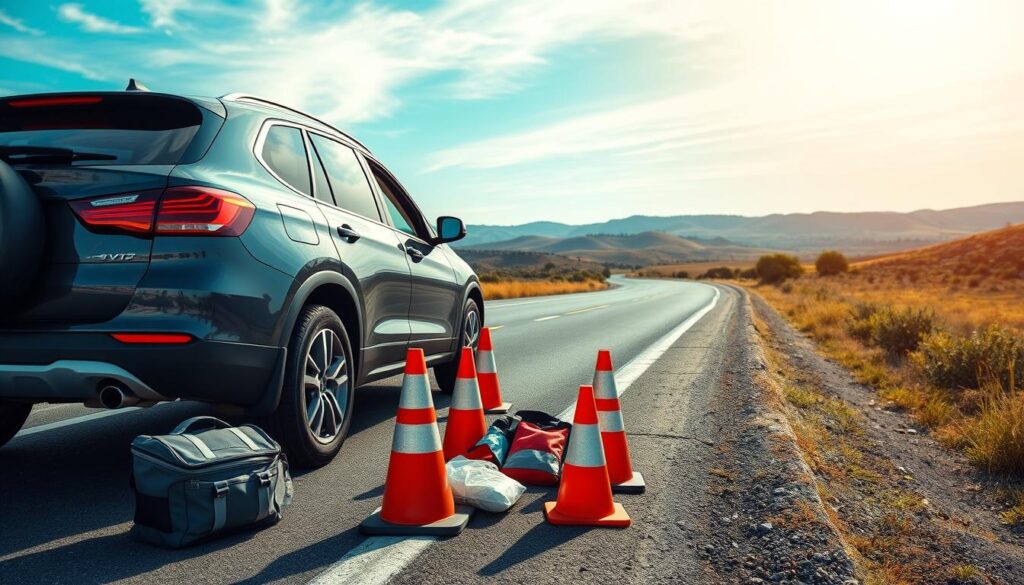
- Keep an emergency kit in our vehicle, including a spare tire, jack, and reflective triangles.
- Know how to change a tire and jump-start a dead battery.
- Stay calm and follow emergency preparedness tips to reduce the risk of accidents.
Being ready and knowing how to handle emergencies keeps us safe on the road. Remember, staying safe on the road is our main goal. By following these tips, we can enjoy a safe and pleasant drive.
Safety Tips for Inclement Weather Driving
Driving in different weather conditions requires us to take driver safety measures to stay safe. The National Weather Service offers tips for safe driving in bad weather. These include slowing down and keeping more distance from other cars.
Driving in heavy rain or snow means you should slow down and leave more space. This helps avoid skidding and accidents. Also, using low-beam headlights in fog makes it easier to see than high-beam headlights.
Preparing for Nighttime Driving Conditions
Night driving is more dangerous in bad weather. It’s important to use reflective lines on the road when it’s foggy. Also, turn off cruise control to stay focused and in control.
Guidelines for High Winds or Fog
High winds and fog make it hard to see, increasing the risk of accidents. Stay calm if your car skids and avoid sudden turns. Lightly tapping the brakes is better than slamming them. Having an emergency kit in your car is also key for safety.
By following these safety tips and taking road safety precautions, we can reduce the risks of driving in bad weather. Always check the weather forecast and plan your route to ensure a safe trip.
| Weather Condition | Safety Tip |
|---|---|
| Heavy Rain or Snow | Reduce speed by 1/3 and increase following distance |
| Fog | Use low-beam headlights and follow reflective lines on the road |
| High Winds | Stay calm during skids and avoid sudden steering movements |
Navigating Emergency Situations on the Road
When you face an emergency on the road, staying calm is key. Grange Insurance says that keeping your cool helps you handle these situations better. A vehicle emergency kit is also vital. It should have a first aid kit, jumper cables, and a spare tire.
Using defensive driving strategies can also prevent accidents. This means being alert, following rules, and guessing what others might do. With these tactics and a good emergency kit, you can lower your accident risk a lot.
Some important things for your emergency kit are:
- A first aid kit
- Jumper cables
- A spare tire
- A flashlight
- A battery-powered radio
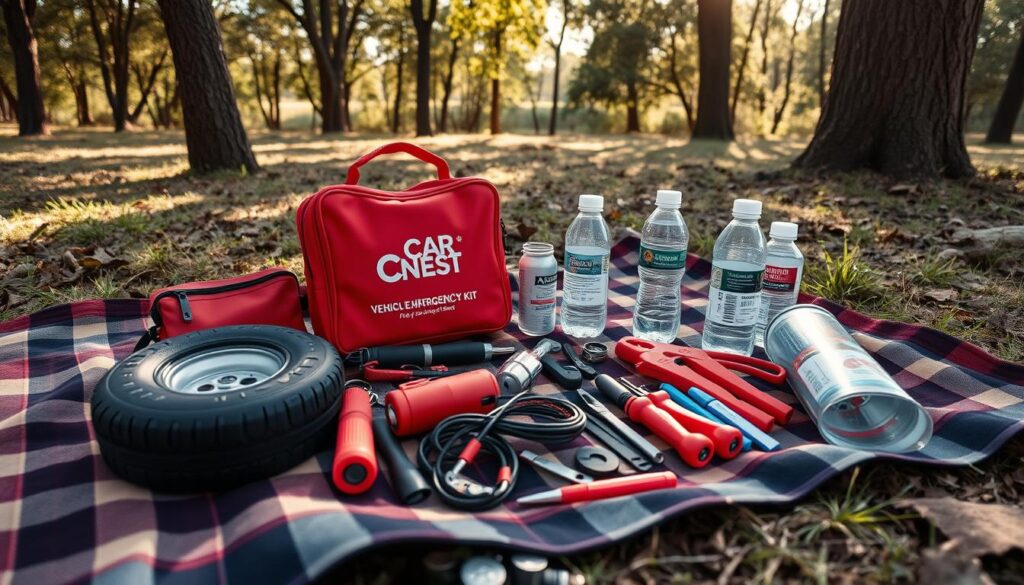
Being ready and knowing how to deal with emergencies makes driving safer for everyone. Always stay calm, think about the situation, and use safe driving habits to avoid accidents.
| Item | Importance |
|---|---|
| First aid kit | High |
| Jumper cables | Medium |
| Spare tire | High |
The Importance of First Aid Knowledge
Staying safe on the road is key, and knowing first aid is vital. Every driver should have basic first aid skills and a first aid kit in their car. The American Red Cross says this is a must.
There are steps we can take to be ready for emergencies. We can take a first aid course to learn CPR and how to treat wounds. We should also put together a first aid kit with things like bandages and pain relievers.
Basic First Aid Skills Every Driver Should Know
Here are some basic first aid skills every driver should know:
- CPR and chest compressions
- Wound cleaning and dressing
- Bleeding control
- Fracture management
What to Include in a First Aid Kit
A first aid kit should have:
- Bandages and band-aids
- Antiseptic wipes and spray
- Pain relievers and antihistamines
- Medical tape and scissors
Having these skills and a first aid kit can help us stay safe on the road. It’s important for every driver to be prepared. First aid knowledge is a big part of that.
Using Technology to Enhance Our Safety
We can make our roads safer by using technology like GPS and emergency contact features. The National Highway Traffic Safety Administration says these tools help keep us safe. Apps like Google Maps and Waze give us real-time traffic updates. This helps us plan our routes better and avoid accidents.
Technology offers many driver safety measures such as navigation systems and emergency alerts. These are very useful in bad weather like heavy rain or snow. By knowing about road safety precautions, we can lower our chances of being in an accident.
Apps for Navigating Hazardous Conditions
There are many apps to help us deal with bad weather. For example, the iExit Interstate Exit Guide helps find gas stations and rest areas on U.S. highways. Apps like bSafe let us discreetly alert an emergency network with just our voice.

GPS and Emergency Contact Features
GPS and emergency contact features are key for our safety. They help us get help fast in emergencies. Systems like Noonlight alert local police if a button is pressed without a pin, helping keep vulnerable people safe.
By using these technologies and staying informed, we can greatly reduce accident risks. This makes our roads safer and more efficient for everyone. As we keep improving driver safety measures, we’ll have a better driving experience.
Practicing Defensive Driving Techniques
Staying safe on the road is key. We must be aware of our surroundings and anticipate dangers. Having a vehicle emergency kit in our car helps us prepare for the unexpected.
Defensive driving means keeping a safe distance, following speed limits, and staying focused. Grange Insurance says this can make driving safer and lower accident risks. Some important strategies include:
- Maintaining a safe following distance to allow for ample reaction time
- Being aware of our surroundings and anticipating possible dangers
- Avoiding distractions while driving, such as using a mobile phone
Using these strategies can greatly lower our accident risk. Also, having a vehicle emergency kit in our car gives us the tools to handle unexpected situations.
Defensive driving courses are also vital. They teach us the skills to stay safe on the road. By learning and practicing defensive driving, we can protect ourselves and others.
Making the Most of Our Driver’s Guide 2025
As we finish our Driver’s Guide 2025, we’re ready to stay safe on the road. We’ve learned how to keep our cars in top shape and be ready for emergencies. This knowledge lets us take care of our vehicles and be ready for anything.
The American Red Cross says it’s key to have a Disaster Supplies Kit in our cars. It should have snacks, water, a first aid kit, and more. Also, tell someone where you’re going and when you’ll get there. Knowing about local disasters and watching the weather helps us stay safe and make smart travel choices.
By following the safety tips in this guide, we can all help make the roads safer. This includes wearing seatbelts, driving slowly, and not driving when we shouldn’t. Keeping our cars in good shape, like cleaning lights and keeping gas tanks full, helps avoid breakdowns and makes driving easier.
Being a good driver means more than just following rules. It’s about being ready for surprises and taking steps to keep everyone safe. Let’s keep focusing on being prepared and use the great info from our Driver’s Guide 2025.
